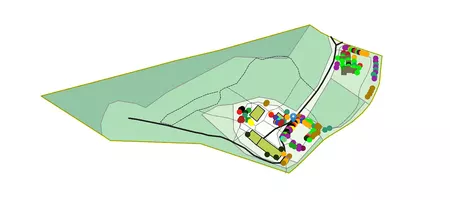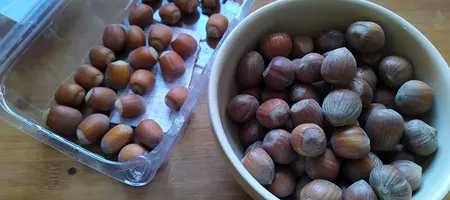Over the past few years, nuts and food forests have become some of the trendiest topics in Finland. While I typically don't subscribe to fads, I'm quite fond of nuts. I remember climbing the enormous walnut trees near our house as a child. The nuts freshly picked from the trees, especially hazelnuts, were scrumptious. My grandfather used to store heaps of them in the cellar, and I would snack on the nuts while playing there.
Why nuts?
As a vegetarian, the paths to obtaining fat are more limited than those of an omnivore. Omnivores can choose to hunt for geese or other meat sources they can find.
While rapeseed is an option, it's not feasible considering the entire process, from planting to making rapeseed oil.
Olives don't grow in Finland. They can be imported, but that involves using a significant amount of fossil fuels for transportation. Importing and exporting aren't really environmentally friendly, right?
There aren't many other plants suitable for oil production – perhaps sunflowers are an option. I'll add it to my to-do list to explore further.
So, many avenues are closed off, which is where nuts come in. Nuts typically have a high oil content, like walnuts, for example, at 65%, and they are delicious when eaten raw. But it's not just about the tasty snack; it's also the potential to press oil from them.
Getting information
I first checked what type of nut trees will grow in the Finnish climate zone 2. I found the following infos from different nurseries and of course the PFAF database:
- Corylus avellana – Hazelnut – Winter hardy down to -20°C, some cultivars down to -35°C
- Juglans regia – Walnut – winter hardy, but unclear if they will survive -35°C
- Juglans nigra – Black walnut – Winter hardy, could survive -35°C
- Juglans cinerea - Butternut - Winter hardy, could survive -35°C
- Castanea sativa – Sweet chestnut – Winter hardy down to -25°C, might tolerate -35°C for some time.
- Prunus amygdalus – Almonds – some cultivars state that -35°C is possible, even lower
- Cary ovate – Hickory nuts – winter hardy down to -20°C
- Macadamia integrifolia – USDA hardiness 9 – 12, which is -6.7 max
- Carya illinoensis – Pecan nut – USDA 5 -9, which is -20 max
- Pinus sibirica – Siberian pine nuts – USDA 1 -6, which is -60°C
- Pinus cembra – Swiss pine nuts – USDA 1-6, which is -60°C
Size of nut trees matter
When I started researching nuts, I also paid attention to their size and unique characteristics. Lumia and I then took a walk around our property and identified some potential planting spots.
I already discussed Hazelnuts in detail in "Growing Hazelnuts in Finland" Since they can tolerate shade and don't grow as tall as, for example, walnut trees, they were easier to place. They could be positioned between rows of apple trees or on the edge of a forest.
For the other nut trees, we found spots where we either had to cut down trees, where trees had already been cut, or where no other trees were growing.
Where and what?
When we came to Finland I already had thought of having nut trees in different areas of Beyond Buckthorns. We identified certain areas with beneficial micro climates in different zones. Some were more suitable than others. Walnut trees are usually solitary trees and not part of a food forest.
In our design we made sure that we followed a multiple elements for important functions and everything gardens approach. This means we bought different trees from different suppliers but also used seeds and dug up trees. For example, when we were in Germany we went onto a scavenger hunt and collected hundreds of nuts and several young trees. One of the largest quantity we got from a Hall’s giant – roughly 200 nuts. The hazelnuts we partly fed to our squirrels. They will forget some of their treasures and we will get a tree every here and there. It is just about identifying them at one point.
Nursery
While having the squirrels as co-creators I put the others into DIY air-pots. The juglans look promising, but I haven’t been that successful with hazelnuts. From my perspective they have been far better when directly seeded into the final destination. You can check our Facebook page if we have any saplings for trade – or subscribe to our newsletter. (You should subscribe to our newsletter anyway)
The nut trees at Beyond Buckthorns
The trees got selected by their availability from different breeder and also what is possible in the Finnish hardiness zones 2. Another criteria was the amount of space needed. We didn’t plant any Aesculus. They need a lot of space and we don’t have any use for it.
Here is the list of nut trees we care for at Beyond Buckthorns in 2023. (only those accounted for, not the wild ones):
| Name | Amount | Zone |
| Corylus avellana | 3 | Zone 4 |
| Corylus avellana | 4 | Zone 2 |
| Corylus avellana – Hallesche Riesennus | 2 | Zone 2 |
| Corylus maxima | 1 | Zone 2 |
| Juglans nigra | 2 | Zone 4 |
| Castanea sativa | 3 | Zone 4 |
| Corylus colurna | 2 | Zone 3 |
The difficulties
Castanea sativa experiences dieback every year. It grows new branches from the root but then dies again in the winter. Perhaps one year, they will be hardy enough to avoid dying back.
Not all cultivars survived the winter. Some of them died. We also underestimated the rabbits' appetite. One of the hazel trees (Corylus avellana) lost 50 cm, while the other lost only a few branches. Regardless, it needs good protection against rabbits.
The Juglans regia trees didn't make it – none of them – neither in the greenhouse nor outdoors.
Juglans nigra trees are looking good so far. Their growth is not very rapid. We need to measure their yearly growth and record it in our plant database.
The pines are thriving. What else would you expect from pines in Finland?
What is next?
In 2023 we will plant Almond trees, more Corylus avellana, more Pinus cembra and some more Castania sativa.
Over time we are going for more diversity in the Corylus genus. We will check for nuts and trees when one of us is in Germany - my aunts backyard is full of them and they are basically everywhere. Of course we will also check what is available here in Finland and generally in Europe.
Thanks to Philipp Weiss's presentation about Urban Edible Landscapes I'll check Juglans cinerea.






